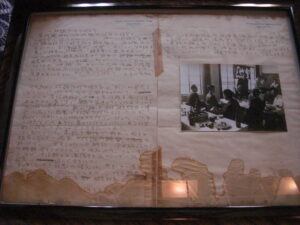真核生物の起源:Origin of Eukaryote
現在の好気性環境の覇者、真核生物はどこで生まれたのだろうか?それはシアノバクテリアのバイオマットであったと考えられる。
真核生物が誕生したであろう先カンブリア時代はまだ海も大気も嫌気性だった。当時の光合成の主役はシアノバクテリアで、それが作ったストロマトライトと呼ばれる方解石の化石がいたるところで発見される。ストロマトライト表面のシアノバクテリアのバイオマットでは、光合成で解放された酸素が蓄積する。このため現在の地球の酸素濃度を超える「酸素オアシス」が出現する。このようなバイオマットは、食物が豊富で、乾燥から守られた比較的住みやすい環境であった。一方で、紫外線に常時さらされる酸素オアシスにおいては、紫外線をはじめとする電離放射線の害を防ぐ必要が出てきた。酸素は、電離放射線の害を増幅させる。このような中で、真核生物の共通祖先Last Common Eukaryote Ancestor (LCEA)は、まず電離放射線に耐えるための進化を遂げたと考えられる。その結果、ヒストンによるクロマチン構造とステロイドを獲得した。ヒストンによるクロマチン構造は、遺伝子情報を保存するDNAを強く凝縮することを可能にした。その結果DNA損傷が格段に減少したと考えられる。また、深く折りたたまれたクロマチン構造を効率的に運用するために、チューブリンを中心とした有糸分裂機構が発達したと考えられる。一方、活性酸素の害の除去のために獲得されたステロイドは、細胞膜に柔軟性を付与した。これにアクチンを使った原形質流動機能が加わって、食胞機能を獲得した。この後、LCEAは、バイオマットの微生物共生環境をそのまま食胞機能で取り込んで、真核生物となった。
Where was eukaryote, the champion of aerobic environment, like surface of the present earth, born in the Precambrian earth, in which both ocean and atmosphere is anaerobic? It was a bio-mat of cyanobacteria to form stromatlite.
The major producer of photosynthesis was cyanobacteria at that time. Stromatolites, calcite fossils of their bio-mat, can be commonly seen in sediments at that time. In such a bio-mat, molecular oxygen was accumulated by photosynthesis and an Oxygen oasis with an oxygen concentration even higher than the present earth. The surface of the bio-mat was relatively good environment to live because of rich food supply and protection from dehydration and temperature changes. On the other hand, they have to protect themselves from the ionization radiation such as UV radiation in oxygen oasis: Oxygen enhances poisonous effect of ionizing radiation. Last common eukaryote ancestors (LCEA) evolved in such selection stress in cyanobacteria bio-mat and got two tools, those are a chromatin structure with histone proteins and steroid. Chromatin structures reduce volumes ocupaied by DNA in a nucleus of eukaryote by a large factor. It reduces damages in DNA, since radiation dose are propotional to the volume. In order to organize deeply folded DNA strands, a molecular machine system of mitosis division of a cell, developed based on tubulins. On the other hand, steroid, originally had used as a scavenger of reactive oxygen species, gave a cell membrane flexibility to allow strong deformations. Combination of a protoplasm flow system based on actin filament and a flexible cell membrane with steroid allowed LCEAs to have phagocytosis. After that, an LCEA incorporated a symbiotic environment of bio-mat in its body by phagocytosis to be an eukaryote.
書籍版『科学はひとつ』のご案内
戎崎俊一 著
学而図書/四六判 並製320頁/本体2,400円+税
12年にわたり執筆されてきた記事を精選し、「地震と津波防災」など全9章に再編。すべての章に著者書き下ろしの解説を加えて集成した一冊。




